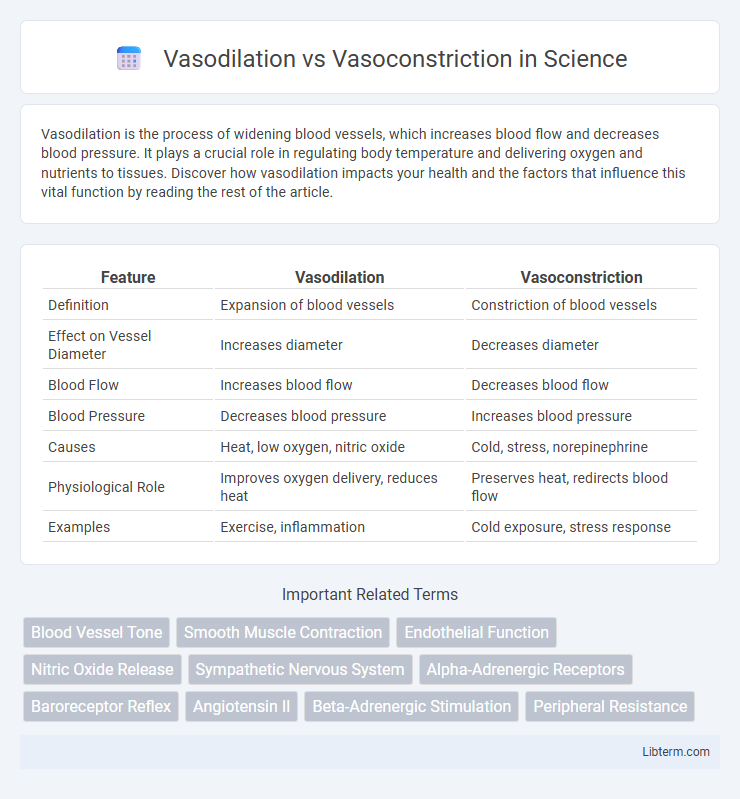Vasodilation is the process of widening blood vessels, which increases blood flow and decreases blood pressure. It plays a crucial role in regulating body temperature and delivering oxygen and nutrients to tissues. Discover how vasodilation impacts your health and the factors that influence this vital function by reading the rest of the article.
Table of Comparison
| Feature | Vasodilation | Vasoconstriction |
|---|---|---|
| Definition | Expansion of blood vessels | Constriction of blood vessels |
| Effect on Vessel Diameter | Increases diameter | Decreases diameter |
| Blood Flow | Increases blood flow | Decreases blood flow |
| Blood Pressure | Decreases blood pressure | Increases blood pressure |
| Causes | Heat, low oxygen, nitric oxide | Cold, stress, norepinephrine |
| Physiological Role | Improves oxygen delivery, reduces heat | Preserves heat, redirects blood flow |
| Examples | Exercise, inflammation | Cold exposure, stress response |
Introduction to Vasodilation and Vasoconstriction
Vasodilation refers to the widening of blood vessels caused by the relaxation of smooth muscle cells in the vessel walls, leading to increased blood flow and decreased blood pressure. Vasoconstriction involves the narrowing of blood vessels due to the contraction of these muscles, resulting in reduced blood flow and elevated blood pressure. Both processes play critical roles in regulating cardiovascular function, thermoregulation, and oxygen delivery to tissues.
Definitions: What is Vasodilation? What is Vasoconstriction?
Vasodilation is the physiological process where blood vessels widen due to the relaxation of smooth muscle cells in the vessel walls, resulting in increased blood flow and decreased blood pressure. Vasoconstriction refers to the narrowing of blood vessels caused by the contraction of these smooth muscle cells, leading to reduced blood flow and elevated blood pressure. Both mechanisms play crucial roles in regulating vascular resistance and maintaining homeostasis within the circulatory system.
Key Differences Between Vasodilation and Vasoconstriction
Vasodilation refers to the widening of blood vessels caused by relaxation of the muscular walls, which increases blood flow and decreases blood pressure. Vasoconstriction involves the narrowing of blood vessels due to contraction of the muscular walls, reducing blood flow and raising blood pressure. Key differences include their opposite effects on vessel diameter, blood pressure regulation, and their role in thermoregulation and oxygen delivery to tissues.
Physiological Mechanisms of Vasodilation
Vasodilation involves the relaxation of vascular smooth muscle cells, primarily regulated by endothelial-derived factors such as nitric oxide (NO), which activates guanylate cyclase in smooth muscle, increasing cyclic GMP levels and causing muscle relaxation. This process enhances blood flow and decreases vascular resistance, aiding in the regulation of blood pressure and tissue perfusion. In contrast, vasoconstriction is mediated by agents like endothelin-1 and sympathetic nervous system activation, leading to smooth muscle contraction and reduced vessel diameter.
Physiological Mechanisms of Vasoconstriction
Vasoconstriction involves the narrowing of blood vessels due to the contraction of smooth muscle cells in the vessel walls, primarily regulated by the sympathetic nervous system through norepinephrine release. This physiological mechanism reduces blood flow and increases vascular resistance, playing a crucial role in maintaining blood pressure and redirecting blood flow during stress or cold exposure. Key molecular mediators include endothelin-1, angiotensin II, and calcium ions, which activate smooth muscle contraction via intracellular signaling pathways.
Factors Influencing Vasodilation and Vasoconstriction
Vasodilation and vasoconstriction are primarily influenced by factors such as nitric oxide, endothelin, and autonomic nervous system activity, which regulate blood vessel diameter to control blood flow and pressure. Chemical signals like prostaglandins, histamine, and adrenaline play key roles in promoting vasodilation or vasoconstriction depending on physiological needs. Environmental factors including temperature, stress, and oxygen levels also significantly impact the balance between vasodilation and vasoconstriction.
Effects on Blood Pressure and Circulation
Vasodilation causes the relaxation and widening of blood vessels, leading to decreased blood pressure and enhanced blood flow to tissues. Vasoconstriction results in the narrowing of blood vessels, increasing resistance and elevating blood pressure while reducing circulation to peripheral areas. These physiological processes regulate oxygen delivery, nutrient transport, and overall cardiovascular function by controlling vessel diameter and systemic vascular resistance.
Clinical Significance and Related Disorders
Vasodilation involves the widening of blood vessels, which decreases vascular resistance and lowers blood pressure, playing a critical role in conditions like hypertension, shock, and heart failure by improving tissue perfusion. Vasoconstriction narrows blood vessels, increasing resistance and blood pressure, and is crucial in disorders such as Raynaud's phenomenon, hypertension, and peripheral artery disease by restricting blood flow to tissues. Understanding the balance between vasodilation and vasoconstriction is essential for managing cardiovascular diseases, optimizing drug therapies like vasodilators and vasoconstrictors, and preventing complications related to impaired vascular tone.
Medical Applications and Treatment Implications
Vasodilation involves the widening of blood vessels, enhancing blood flow and reducing blood pressure, which is crucial in treating conditions like hypertension, angina, and heart failure through medications such as nitrates and calcium channel blockers. Vasoconstriction, the narrowing of blood vessels, increases vascular resistance and blood pressure, playing a vital role in managing hypotension and shock with agents like vasopressors and alpha-agonists. Understanding the balance between vasodilation and vasoconstriction is essential for optimizing therapeutic strategies in cardiovascular, respiratory, and critical care settings to improve patient outcomes.
Summary: Balancing Vascular Tone for Health
Vasodilation and vasoconstriction are critical processes regulating vascular tone by expanding or narrowing blood vessels to control blood flow and pressure. Maintaining a balance between these mechanisms supports cardiovascular health, preventing hypertension, improving tissue perfusion, and reducing the risk of vascular diseases. Dysregulation of vascular tone can lead to pathological conditions such as atherosclerosis, stroke, and heart failure.
Vasodilation Infographic

 libterm.com
libterm.com